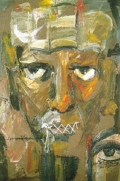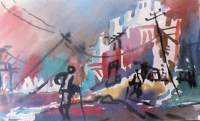Modern and contemporary visual arts
 From the late 19th century onwards Afghan artists began to experiment with western techniques, but the results were wholly derivative with no recognisably Afghan characteristics. The National Art Gallery was filled with European paintings in the Victorian style and later works copied from pictures in arts books. Even though it is thought that the first depictions of Buddha as a being originated in Afghanistan, sculpture never became popular in this Islamic society. From the late 19th century onwards Afghan artists began to experiment with western techniques, but the results were wholly derivative with no recognisably Afghan characteristics. The National Art Gallery was filled with European paintings in the Victorian style and later works copied from pictures in arts books. Even though it is thought that the first depictions of Buddha as a being originated in Afghanistan, sculpture never became popular in this Islamic society.The German influence developed as a ‘third force ‘ to balance the powers of the British/American and Russian groups. The Germans were the largest foreign colony and began building schools and sending teachers to work in the universities and high schools. The Fine Arts College, predecessor of Afghan Traditional Arts Training School - Ghulam Mohammad Maimanagi, was located in the Isbn Durrani School (now a girls’ school) and taught ceramics, sewing, painting, carpet and fabric weaving and printing. There were two directors - one German who taught technique and one Afghan administrator - and each class had both a German teacher and an Afghan assistant. When Afghan artist Abdul Ghafur Breshna (1907-1974) came back from Germany in 1933, he became Director of this school. He subsequently helped to standardise the quality of Afghan arts and crafts and did much to promote western styles of painting and sculpture. During this period all the materials and tools came from Germany and were of the highest quality.
 Today there are few art galleries in which artists can display their work, although Afghan NGO Co-ordination of Humanitarian Assistance (CHA) has two rooms in which artists can exhibit. Work displayed there is generally concerned with traditional Afghan themes, buzkashi games, teapot repairmen or street and bazaar scenes. A few ‘modern’ artists have pieces on view which capture the styles of impressionist and later European artists to a remarkable degree. Today there are few art galleries in which artists can display their work, although Afghan NGO Co-ordination of Humanitarian Assistance (CHA) has two rooms in which artists can exhibit. Work displayed there is generally concerned with traditional Afghan themes, buzkashi games, teapot repairmen or street and bazaar scenes. A few ‘modern’ artists have pieces on view which capture the styles of impressionist and later European artists to a remarkable degree. |
|
||||||

You are here: Welcome to the Afghanistan Cultural Profile > Culture in Afghanistan > Visual arts > Modern and contemporary visual arts
| ||||||


|
||||||
|
|
 |
created with financial support from
Date updated: 18 August 2004
|
||||
The website is powered by a Content Management System developed by Visiting Arts and UK software company Librios Ltd http://www.librios.com

